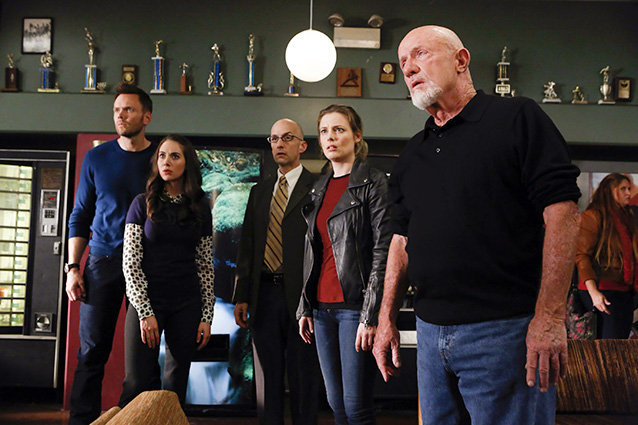 NBC Universal Media
NBC Universal Media
When Community was finally canceled by NBC, it was really just the wrap-up of a death march that has been playing out in slow motion for years. Actually, it could be argued that the fact that Dan Harmon’s quirky ensemble sitcom set at a community college managed to make it as long as it did on a network is a victory in and of itself.
Network television has always had difficulty knowing what to do with smart, off-beat comedies, whether it was Taxi in the late ’70s, NewsRadio in the ’90s, Arrested Development in the 2000s, or Happy Endings this decade. Shows that need time to build an audience as more people get in on the joke perplex executives that are looking at ratings and ad revenue that don’t add up. The fact that Community had a stellar cast headlined by Joel McHale, featured some of the most original writing on television and regularly took chances by embracing its uniqueness (and, yes, stunts like making an animated episode or setting a storyline against the backdrop of a pillow fort war) gets lost in the shuffle of bottom line numbers.
The thing is that you would expect that networks would’ve learned their lessons by now… since their counterparts on the cable side have been trying to show them the way for a while now.
Social Media Is Your Friend
Sitcoms like Workaholics on Comedy Central and The League on FXX, have loyal followings that their broadcasters try to cater to instead of alienate. They make the group that is in on the show’s humor feel like they’re part of a cool club. Counterparts like Louie on FX and Maron and Portlandia on IFC do the same thing and are also savvy about using social media to promote the shows. Instead of just sending out generic “Hey, watch our show” messages, as the networks regularly do, they utilize and encourage the online followings that their stars walked in the door with.
NBC has used their website effectively for a decade now to provide additional content for some of its comedy programming — The Office, Saturday Night Live, and even Community come to mind — but all of the networks continuously lag behind in embracing other new avenues to reach desirable audience members as they start to carry real cache, like Twitter and Instagram. With Facebook having been part of the public’s consciousness for nearly a decade now, there’s been plenty of time for network executives to become forward thinking in regards to social media, instead of continuously being reactionary.
Have Realistic Expectations
Nobody is expecting a network to have the flexibility that HBO has when it comes to the sort of content that they can handle on everything from Veep to Girls to Eastbound and Down… but networks have more flexibility than they are willing to admit. A sitcom doesn’t have to have swearing or nudity to be buzz-worthy… it just needs to be done well by people that are given the freedom to enact their vision.
In today’s fractured market, cultivating a TV show that has a smaller but desirable audience should be a true option for any network. By keeping production costs down and cultivating a specific audience base before the show hits the air, a network should be able to get away with smaller ratings for a sitcom. Ratings only truly matter when it comes to setting ad rates, but that’s a model that hasn’t changed much since Nielsen started tracking it in the early ’60s… and it’s a system that is ripe for change.
Targeted TV ads are the wave of the future, but selling broader based ads for a show that is reaching a key demographic isn’t that hard. NBC already off-sets the cost of The Biggest Loser by partnering with advertisers that want to reach women 18 to 34 with disposable income are willing to pay to be a part of the show. Smart comedies have their own key demo, and it’s typically affluent 18 to 34-year-olds. It seems like a target audience that a lot of advertisers could use.
Remember Seinfeld
One of the biggest hits of the last 25 years should provide all of the incentive any network needs to remember the importance of cultivating a show that is initially too hip for the audience. When Jerry Seinfeld and Larry David’s show first started, it didn’t have a suitable spot on the NBC schedule and bounced around. It wasn’t until Seinfeld‘s third season that it really began to catch on with a bigger audience, and it wasn’t until the fourth season that it was really a hit.
Seinfeld also produced shorter seasons its first two years, something that cable networks have now been doing successfully for a while now (and British television has always done). Networks have seemingly been more flexible with doing that with hour-long programming than with sitcoms, yet there’s no reason that a 13-episode comedy can’t work just as well if marketed properly. If networks can figure out a way to sell an audience on fantasy shows like Once Upon a Time or intricate dramas like The Blacklist, they should be able to figure out how to sustain smart comedies like Community and Happy Endings.


